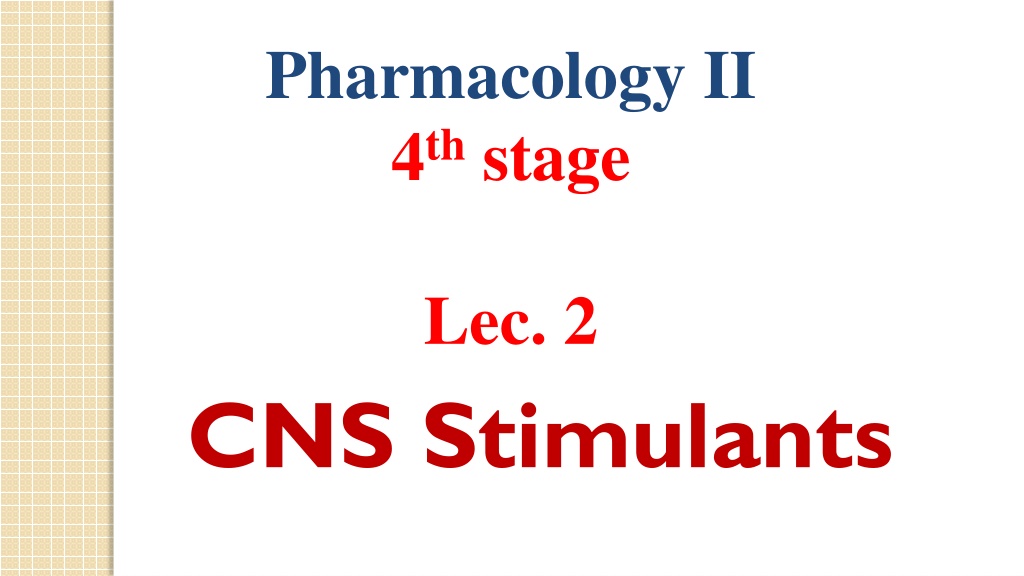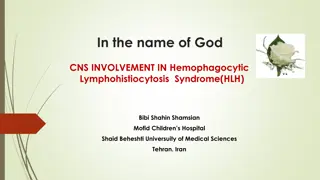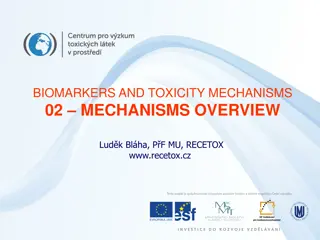Understanding CNS Stimulants and Their Mechanisms of Action
CNS stimulants are a type of drug that increase certain chemicals in the brain, enhancing alertness, attention, energy, and physical activity. This article explores psychomotor stimulants like caffeine, nicotine, cocaine, amphetamine, and methylphenidate, discussing their mechanisms of action and effects on the central nervous system. The methylxanthines group, including theophylline, theobromine, and caffeine, are highlighted for their stimulant properties. The inhibition of phosphodiesterase enzymes and actions on the CNS and cardiovascular system are also examined.
Download Presentation

Please find below an Image/Link to download the presentation.
The content on the website is provided AS IS for your information and personal use only. It may not be sold, licensed, or shared on other websites without obtaining consent from the author. Download presentation by click this link. If you encounter any issues during the download, it is possible that the publisher has removed the file from their server.
E N D
Presentation Transcript
Pharmacology II 4thstage Lec. 2 CNS Stimulants
CNS Stimulants A type of drug that increases the levels of certain chemicals in the brain and increases alertness, attention,energy,and physical activity. CNS stimulants also raise blood pressure and increase heart rate and breathing rate.
CNS Stimulants two groups of drugs that act primarily to stimulate the central nervous system (CNS). The first group, the psychomotor stimulants, cause excitement and euphoria, decrease feelings of fatigue, and increase motor activity. The second group,the hallucinogens, produce profound changes in thought patterns and mood.
Psychomotor Stimulants include A. Methylxanthines B. Nicotine C. Cocaine E. Amphetamine F. Dextroamphetamine G. Methylphenidate
A.Methylxanthines The methylxanthines include Theophylline which is found in tea; Theobromine,found in cocoa;and Caffeine found in coffee, tea, cola drinks, chocolate,and cocoa.
Mechanism of action:includes, inhibition of phosphodiesterase enzyme : lead to increase cyclic adenosine monophosphate cAMP and cyclic guanosine monophosphate cGMP . blockade of adenosine receptors.
inhibition of phosphodiesterase enzyme No: nitric oxide GC: guanylyl cyclase AC: Adenylyl cyclase PDE: phosphodiesterase
Actions CNS: The caffeine contained in one to two cups of coffee (100-200 mg) causes a decrease in fatigue and increased mental alertness. Consumption of 1.5 g of caffeine (12 to 15 cups of coffee) produces anxiety and tremors. Tolerance can rapidly develop to the stimulating properties of caffeine;withdrawal consists of feelings of fatigue and sedation.
Cardiovascular system: A high dose of caffeine has positive inotropic and chronotropic effects on the heart. Diuretic action: Caffeine has a mild diuretic action that increases urinary output of sodium, chloride, and potassium.
Gastric mucosa: Because all methylxanthines stimulate secretion of hydrochloric acid from the gastric mucosa,individuals with peptic ulcers should avoid beverages containing methylxanthines.
Therapeutic uses: Caffeine and its derivatives relax the smooth muscles of the bronchioles so it can be used in asthma. Pharmacokinetics: The methylxanthines are well absorbed orally. All the metabolized in the liver and excreted in the urine. methylxanthines are Adverse effects: Moderate doses of caffeine cause insomnia,anxiety,and agitation.
B.Nicotine Nicotine is the active ingredient in tobacco. In low doses, nicotine causes ganglionic stimulation by depolarization. At high doses, nicotine causes ganglionic blockade.
Actions: CNS: Nicotine is highly lipid soluble and readily crosses the blood-brain barrier. Cigarette smoking or administration of low doses of nicotine produces some degree of euphoria and relaxation. It improves attention, learning,problem solving.
High doses of nicotine result in central respiratory paralysis and severe hypotension caused by medullary paralysis . Nicotine is an appetite suppressant.
Peripheral effects: Stimulation of sympathetic ganglia as well as the adrenal medulla increases blood pressure and heart rate. Stimulation of parasympathetic ganglia also increases motor activity of the bowel.
At higher doses, the activity ceases in both the gastrointestinal tract and bladder musculature as a result of a nicotine-induced block of parasympathetic ganglia.
Pharmacokinetics: Because nicotine is highly lipid soluble, absorption readily occurs via the oral mucosa, lungs, gastrointestinal mucosa,and skin. Nicotine crosses the placental membrane and is secreted in the milk of lactating women. Clearance of nicotine involves metabolism in the lung and the liver and urinary excretion.
Adverse effects: irritability, tremors, intestinal cramps, diarrhea,and increased heart rate and blood pressure. Withdrawal syndrome: nicotine is an addictive substance. Withdrawal is characterized by irritability, anxiety, restlessness, difficulty concentrating,headaches,and insomnia.
C.Cocaine Cocaine is a widely available and highly addictive drug. The primary mechanism of action is blockade of reuptake of the monoamines (norepinephrine, dopamine) into the presynaptic terminals from neurotransmitters are released. serotonin, and which these
Actions: CNS: Cocaine acutely increases mental awareness and produces a feeling of well-being and euphoria. at high doses, it causes tremors and convulsions, followed by respiratory depression.
Sympathetic nervous system: Peripherally, cocaine potentiates the action of norepinephrine ,this is associated with tachycardia, hypertension, pupillary dilation,and peripheral vasoconstriction.
D.Amphetamine Amphetamine shows effects quite similar to those of cocaine. Mechanism of action As with cocaine, the effects of amphetamine on the CNS and peripheral nervous system are indirect; that is, both depend upon an elevation of the level of catecholamine neurotransmitters in synaptic spaces. Amphetamine, however, achieves this effect by releasing intracellular stores of catecholamines.Amphetamine also inhibits monoamine oxidase (MAO).
Actions: CNS: increasing the release of dopamine and norepinephrine leads to increased alertness, decreased fatigue, depressed appetite, and insomnia. These CNS stimulant effects of amphetamine and its derivatives have led to their use in therapy for hyperactivity in children, narcolepsy,and for appetite control.
Narcolepsy is a relatively rare sleep disorder that is characterized by uncontrollable bouts of sleepiness during the day. It is sometimes accompanied by catalepsy, a loss in muscle control, or even paralysis brought on by strong emotions, such as laughter. However, it is the sleepiness for which the patient is usually treated with drugs such as amphetamine ,methylphenidate and modafinil.
Attention deficit hyperactivity disorder (ADHD) Some young children are hyperkinetic and lack the ability to be involved in any one activity for longer than a few minutes.
F.Methylphenidate Used for the treatment of ADHD. Children with ADHD may produce weak dopamine signals, methylphenidate is a more potent dopamine transport inhibitor than cocaine, thus making more dopamine available. Adverse reactions: Gastrointestinal effects include anorexia, insomnia,nervousness,and fever.
Hallucinogens The individual under the influence of these drugs is incapable of normal decision making, because the drug interferes with rational thought. A. Lysergic acid diethylamide: B.Tetrahydrocannabinol C.Phencyclidine
A. Lysergic acid diethylamide: The drug shows serotonin (5-HT) agonist activity, activation of the sympathetic nervous system occurs. low doses of LSD can induce hallucinations, High doses may produce long-lasting psychotic changes in susceptible individuals.
B.Tetrahydrocannabinol:present in marijuana. THC can produce euphoria, followed by drowsiness and relaxation. In addition to affecting short-term memory and mental activity, appetite stimulation and visual hallucinations.
It is indicated as an appetite stimulant, It is also sometimes given for the severe emesis caused by some cancer chemotherapeutic agents .
The CB1-receptor antagonist,rimonabant,is effective in the treatment of obesity and has been found to decrease appetite and body weight in humans. Adverse effects include increased heart rate, and reddening of the conjunctiva.























